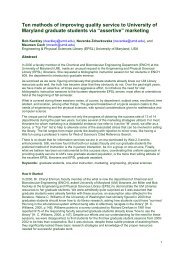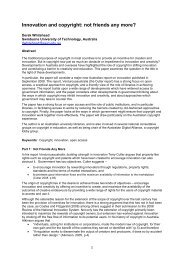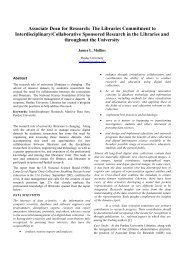Thinking styles and their role in teaching and learning Abstract - IATUL
Thinking styles and their role in teaching and learning Abstract - IATUL
Thinking styles and their role in teaching and learning Abstract - IATUL
Create successful ePaper yourself
Turn your PDF publications into a flip-book with our unique Google optimized e-Paper software.
(1996:42) po<strong>in</strong>ted out, that although each hemisphere is specialized <strong>in</strong> a different way, the<br />
physical connections secure <strong>in</strong>tegrated bra<strong>in</strong> activity. Accord<strong>in</strong>g to Gazzagnia (1998:35) ongo<strong>in</strong>g<br />
research has reaffirmed that:<br />
‘The two hemispheres control vastly different aspects of thought <strong>and</strong> action.<br />
Each half has its own specialization <strong>and</strong> thus its own limitations <strong>and</strong><br />
advantages’.<br />
These theories gave impetus to the development of Herrmann’s whole bra<strong>in</strong> model. Herrmann<br />
used the left/right theory, the triune theory <strong>and</strong> the physical connections between the left <strong>and</strong> right<br />
hemispheres <strong>and</strong> between the upper <strong>and</strong> lower parts of the bra<strong>in</strong> to construct his whole bra<strong>in</strong><br />
model.<br />
The four quadrants of the Herrmann model represent the four th<strong>in</strong>k<strong>in</strong>g structures of the bra<strong>in</strong>. The<br />
left <strong>and</strong> right hemispheres (Sperry’s work) represent our cerebral processes <strong>and</strong> the two halves of<br />
the limbic system (MacLean <strong>and</strong> Herrmann’s work) represents our more visceral (feel<strong>in</strong>g based)<br />
processes. The cerebral mode is the more cognitive, <strong>in</strong>tellectual part of our th<strong>in</strong>k<strong>in</strong>g processes<br />
<strong>and</strong> the limbic mode is the more structured visceral <strong>and</strong> emotional part of our th<strong>in</strong>k<strong>in</strong>g processes<br />
(Herrmann 1995:40). Although an <strong>in</strong>dividual may favour cognitive activities associated with a<br />
specific quadrant, ‘ both hemispheres contribute to everyth<strong>in</strong>g, but contribute differently’ (Ornste<strong>in</strong><br />
1997:94).<br />
Accord<strong>in</strong>g to Herrmann (1995, 1996) a preference for the A-quadrant (left cerebral mode) means<br />
that a person favours activities that <strong>in</strong>volve logical, analytical, fact-based <strong>in</strong>formation. A<br />
preference for the B-quadrant (left limbic mode) implies a l<strong>in</strong>ear approach to activities. Individuals<br />
with a B-quadrant preference favour organized, sequential planned <strong>and</strong> detailed <strong>in</strong>formation.<br />
They are conservative <strong>in</strong> <strong>their</strong> actions <strong>and</strong> like to keep th<strong>in</strong>gs as they are. A preference for the C-<br />
quadrant (processes of the right limbic mode) <strong>in</strong>dicates favour<strong>in</strong>g <strong>in</strong>formation that is <strong>in</strong>terpersonal<br />
feel<strong>in</strong>g-based <strong>and</strong> <strong>in</strong>volves emotion. A preference for the D-quadrant (processes of the right<br />
cerebral mode) is ma<strong>in</strong>ly characterized by holistic <strong>and</strong> conceptual approach <strong>in</strong> th<strong>in</strong>k<strong>in</strong>g.<br />
This model helps to underst<strong>and</strong> mental diversity <strong>and</strong> the important <strong>role</strong> that it has not only for<br />
effective teach<strong>in</strong>g <strong>and</strong> learn<strong>in</strong>g, but as well as a tool to design <strong>and</strong> deliver teach<strong>in</strong>g <strong>and</strong> learn<strong>in</strong>g<br />
activities <strong>in</strong> all four bra<strong>in</strong> quadrants. The model further <strong>in</strong>dicates clearly the iterative nature of the<br />
activities <strong>and</strong> the correlation of the physiology of the <strong>in</strong>terconnected bra<strong>in</strong>.<br />
These specialized mental modes function together situationally <strong>and</strong> <strong>in</strong>teractively mak<strong>in</strong>g up a<br />
whole bra<strong>in</strong> <strong>in</strong> which one or more parts become naturally dom<strong>in</strong>ant. The dom<strong>in</strong>ance between the<br />
paired structures of the bra<strong>in</strong> provides the basis for measur<strong>in</strong>g the level of dom<strong>in</strong>ance. The<br />
Herrmann Bra<strong>in</strong> dom<strong>in</strong>ance Instrument (HBDI) is an assessment tool that quantifies the degree of<br />
a person’s preference for specific th<strong>in</strong>k<strong>in</strong>g.<br />
The Herrmann Bra<strong>in</strong> Dom<strong>in</strong>ance Instrument Tool (HBDI)<br />
Based on extensive research which spans 20 years, Herrmann (1995, 1996) developed an<br />
assessment tool that quantifies the degree of a person’s preference for a specific th<strong>in</strong>k<strong>in</strong>g style –<br />
the Herrmann Bra<strong>in</strong> Dom<strong>in</strong>ance Instrument (HBDI). The results are displayed on a four-quadrant<br />
grid. It takes the form of a survey consist<strong>in</strong>g of 120 questions to be completed by an <strong>in</strong>dividual.<br />
Although Herrmann discusses his model as a metaphor, the bra<strong>in</strong>-based quadrant is aligned with,<br />
<strong>and</strong> supported by various research projects <strong>and</strong> is used a measur<strong>in</strong>g tool for th<strong>in</strong>k<strong>in</strong>g preferences<br />
of <strong>in</strong>dividuals. Because bra<strong>in</strong> dom<strong>in</strong>ance is not solely predeterm<strong>in</strong>ed genetically, but is a result of<br />
genetic <strong>in</strong>heritance <strong>and</strong> parent<strong>in</strong>g <strong>and</strong> teach<strong>in</strong>g, life experiences <strong>and</strong> cultural <strong>in</strong>fluences, bra<strong>in</strong><br />
dom<strong>in</strong>ance is natural <strong>and</strong> normal for all human be<strong>in</strong>gs. This means that bra<strong>in</strong> dom<strong>in</strong>ance<br />
<strong>in</strong>fluences all four specialized th<strong>in</strong>k<strong>in</strong>g structures of the bra<strong>in</strong> <strong>and</strong> not just the two hemispheres.<br />
To date, more that two million HBDI profiles have been done world-wide (Lumsda<strong>in</strong>e, Lumsda<strong>in</strong>e
















